Rock circle significance explored at Galt Museum
By Alejandra Pulido-Guzman on June 16, 2022.
LETHBRIDGE HERALDapulido@lethbridgeherald.com
Members of the community had the opportunity to learn about the importance of names and learning from the land in Blackfoot culture recently at the Galt Museum and Archives.
Through a panel discussion and a site visit to the Galt Museum Medicine Wheel located on the grounds, those in attendance had the opportunity to listen and learn from Mike Bruised Head, Rebecca Many Grey Horses and Bobbie Fox, curators of the Nitsitapiisksakoo Nitsitapii Landscapes exhibit that will be concluding this weekend.
“In collaboration with the exhibit that we have ongoing downstairs, we’re talking about the sites that are within the exhibit, but also we talked about Blackfoot teachings and Blackfoot perspectives on learning from the land,” said Many Grey Horses.
Bruised Head said the discussion offered them an opportunity to share history from a Blackfoot perspective.
“We want to tell our own story, without academics or other researchers telling our story, because it’s somewhat insulting and very privileged thinking when you don’t ask permission to talk about a group of people such as us Blackfoot people,” said Bruised Head.
He said the desire of not having others telling their history made them tell it themselves.
“If we don’t like other people telling our story we have to tell it and that’s the opportunity we’re using today to tell the stories that were passed down from our ancestors,” said Bruised Head.
He said he does not like to call it a medicine wheel as it is a colonial term, he calls them Rock Circles.
“This one (at the museum) is a modern one, to indicate and marking our traditional Blackfoot territory and other rock circles range in date from 5000 years ago to now,” said Bruised Head.
He said Alberta has between 400 and 600 rock circles but they want to keep some to themselves.
“There are a lot more that researchers, archaeologists and anthropologists don’t know about,” said Bruised Head.
He said they do not want to share those publicly because they are tired of them excavating, coming in and invading their cultural space or territory, then going back and saying whatever they want to say from their scientific viewpoint.
“Some areas are very sacred and we don’t want them damaged and we don’t want to allow foreign presence, we don’t want to lose the spirituality of it and we just don’t want to share because they’re very sacred if we make them public, they’ll start coming around and digging anything and everything and the last things we don’t want any misinterpretation of it,” said Bruised Head.
During the event on Friday, those in attendance had the opportunity to stand around the rock circle and learn about the proper protocols to follow when visiting the site.
“Whenever you go to those sites, whether it be Waterton, Writing On Stone or this medicine wheel, make an offering,” said Many Grey Horses.
She said acceptable offerings include tobacco and berries. “Another thing we are saying here today is that it is not just our responsibility as Blackfoot people, but it’s the general public that should be responsible as well in preserving and protecting these sites,” said Many Grey Horses.
Fox said those sites are full of history and she had the idea of creating the exhibit to be able to share the history with non-Blackfoot people and decided to consult with Many Grey Horses and Bruised Head.
“I’ve always been interested in the Blackfoot use of the land and their history and just how they lived on the land and I got the opportunity to do an exhibit about that to kind of explore these sites that everyone knows about but they don’t know the actual history of these sites, and how important they are to the Nitsitapii people,” said Fox.
She said their history has a longevity that is hard to comprehend.
“When this project started out, it was going to be one exhibit and it has become a journey. We realized that there were so many stories to tell, so many sites,” said Fox.
She said they decided to break it up and do more than one exhibit and tell more of those stories.
“We realized that there are all these layers and ways for accessibility for these stories and the importance for people both Blackfoot and non-Blackfoot to learn these stories about the place where we all live,” said Fox.
For information on the exhibit visit https://www.galtmuseum.com/exhibit/nitsitapiisksakoo-nitsitapii-landscapes
Follow @APulidoHerald on Twitter
4-3




